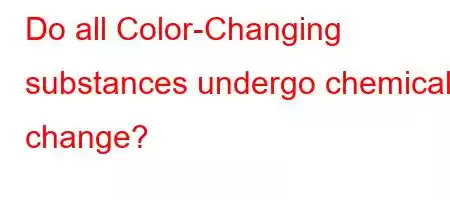Blog Do all Color-Changing substances undergo chemical change?
Contents
Do all Color-Changing substances undergo chemical change?
Physical change is the name given to changes that occur only in the state, shape, and outer appearance of substances without changing their structure. No new substances are formed as a result of physical changes. Only the properties of matter such as color, shape, size change.
What are the signs of chemical change?
Chemical change
Burning of paper Bread molding. Sour milk. Rotting of the egg. Rusting of iron Photosynthesis event, Making yogurt from milk Respiration eventIs the color change physical or chemical?
The events that only change the external structure of matter such as shape, appearance and color are called physical changes. The structure (identity) of the substance does not change, only the space between the particles changes.
Is the color change of litmus paper physical or chemical?
The color change of litmus causes a change in its molecular structure. It is chemical because it is based on a reversible reaction.
Does the particle structure of the substance change in a physical change?
Particulate Structure of Matter Physical Change It is the change that occurs only in the outer appearance of the substance without changing its structure. No new substances are formed as a result of physical changes. Only the properties of the substance such as color, shape, size change. The identity of the substance does not change as a result of physical changes.
What is a chemical change and examples?
Chemical change: Changes that occur in the internal structure of the substance, that is, in its identity, are called chemical changes. Example: Rusting of iron, cooking of eggs, burning of paper, rotting of apples, rancidity of milk…
Is the drying of paint a chemical change?
"Drying of Oil Paint" chemical change is it? Answer: The drying of oil paint is chemical.
Is there a color change in acids?
Litmus turns red when it comes into contact with acid, and blue when it comes into contact with a base. Blue litmus paper turns red in acidic environments and red litmus paper turns blue in alkaline environments (eg alkaline). The color change is in violet tones in the pH range of 4.5-8.3 (at 25 °C).
Read: 222


